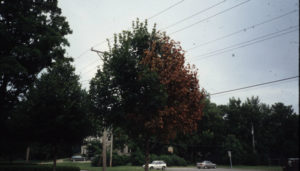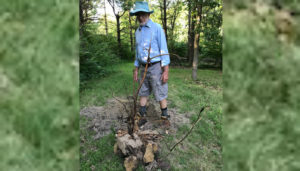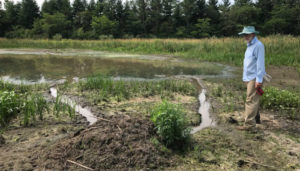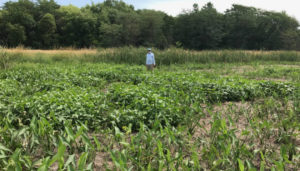The Value of Drought

This year, spring and early summer had quite adequate rainfall. But as we slip into late summer and early autumn, we are also slipping into a dry spell. If you are growing annuals, whether field corn or tomatoes, there is not much good you can imagine from drought. But for folks who are into conservation, where the “crop” is prairie, wetland, or woodland, moderate drought is part of the native setting and serves useful purposes.
In a forest, new seedlings are especially vulnerable, and drought is a thinning process, which tends to help maintain the native oak-hickory savanna ecosystem. For saplings, which are already a few years old and have successfully grown a serious taproot, a moderate drought forces them to track soil moisture downward and then they are better prepared for more serious droughts, which will come later in their lifetimes. And the cracks that open up in the soil become conduits for roots, humus, and rainfall, not only helping roots downward in the short term, but also deepening the soil profile over the long term.

Trees with root problems reveal this during drought by their canopy going dormant or dead on the side with the problem. In suburbia, it often indicates roots cut by trenching for pipelines or cable. In industrial areas, it can be indication of a contaminant plume.
If you are planting trees in the field, the best survivors will usually be those grown directly in the soil from seed, because their first big push is often to send down a taproot, By contrast, nursery stock is often root pruned, sometimes repeatedly, in order to create a compact root mass, which can be potted or ball and burlapped and readily transported. Once more than a couple of years old, trees turn off the taproot genes and turn on the program to grow long shallow laterals to anchors the spreading canopy, which leaves them more vulnerable to drought, as shallow soil moisture disappears.

Upside-down mulberry stump, 16 years old. Taproot now straight up, I cut the large laterals off in order to pull it out with tractor.
A reasonable compromise is to grow native tree seedlings in tall, slender pots for one summer, transplant them in autumn to their field location with a foot-long taproot, and water and mulch well to get them through their first winter without frost heave.
Many of our wetlands work their way through wet and dry hydrologic cycles. A half-century ago, Paul Errington studied these cycles in the prairie pothole region of Iowa-Minnesota and found muskrats to be the keystone species. They are mostly vegetarian, and in a wet cycle they breed prolifically, building as many as a dozen winter houses per acre. But when the next drought cycle arrives, the plants stop growing and the muskrats are then grossly overpopulated.

An abandoned winter muskrat house foreground, with two muskrat-dug canals leading to/from it, which allowed them to swim under the ice even in very shallow water.
Like all animals, including us, their tolerance for near neighbors then plummets and their Four Horsemen of the Apocalypse come riding in. By then, they have eaten every green shoot and dug up every tuber they can find, and the wetland becomes a barren mudflat (an “eatout”). Refugees wander around on the uplands, getting picked off by predators, and we notice them as roadkill.

Following two wet years plus a wet 2017 spring, this patch of wapatoo, aka duck potato, is flourishing in spite of present mini-drought because this was a shallow pond. On the Lewis and Clark expedition, Sacajawea often gathered these little potatoes to help feed the troops.
But the wetland ecosystem has been through this cycle many times before. The plants have prepared, with buried seeds, tiny bulbs, inedible rhizomes, deep suckers, and other “propagules,” which are programmed to stay dormant and cryptic until the wet cycle returns, even if years later. And then the few surviving muskrats find themselves in lush city and the cycle repeats.
Without drought, fire, and grazing working together, all of southeast Iowa would be forested in its native condition, to the nearly complete exclusion of prairie. Today’s remnants and planted prairies need constant management to restrain the trees and shrubs.
So our native woodlands, wetlands, and prairies all get part of their operating instructions from drought. As conservation designers and managers, our assignment is to include drought in a landscape’s portfolio and recognize its role when it occurs.


